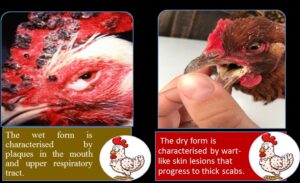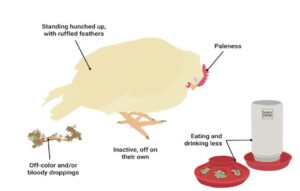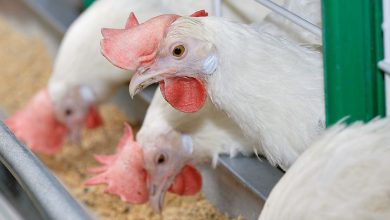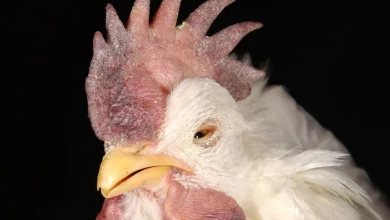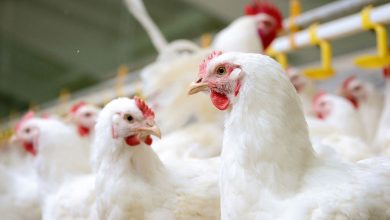PROBLEMS ASSOCIATED WITH POULTRY IN THE RAINY SEASON
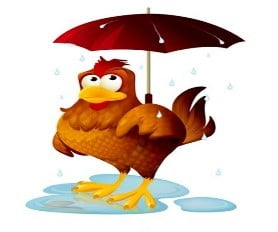
1 Dr. Gunjan Sharma, 2 Dr. Richa Tiwari.1 BVSc & AH, MVSc Scholar in Animal Nutrition,
Dr. G. C. Negi college of Veterinary and Animal Sciences, Palampur, Himachal Pradesh
2BVSc & AH, MVSc (Veterinary Public Health and Epidemiology), Guru Angad Dev Veterinary and Animal Sciences University, Ludhiana, Punjab,India
Introduction: The term “poultry” includes various species of domesticated birds. The poultry business is one of the most rapidly growing business globally. Despite all these mileages, the poultry business is seriously tormented by extreme seasonal conditions. Like any other season, the rainy season can also be a cause of stress to poultry. The rainy season may fetch various diseases for birds. This extreme weather condition may cause immuno-suppression that can drastically affect the bird’s productivity. The main problem of the rainy season is not only because of low temperature and high humidity but due to the dripping water from many sources that may bring various parasites and pathogens.
Prevalence of major poultry diseases encountered during rainy season:
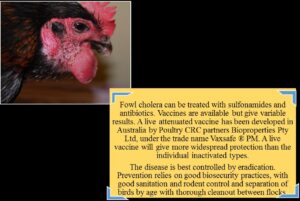
Fowl pox: This disease is caused by pox virus. It is a contagious disease and can be deadly. Mosquitoes and other blood-sucking insects are the main agents and the rainy season is appropriate weather for them to multiply. The clinical signs of this disease include lesions on the wattle, face, comb, and sometimes on the legs. In severe cases, pox virus can cause lesions in the throat that can make the chicken suffocate.
Infectious Bursal Disease (Gumboro): It is caused by birna virus. It affects immature birds (3 to 18 weeks old). Majorly, this disease affects the bursal component of the immune system of chicken that may lead to immuno-suppression. Signs of the disease can include a rapid drop in feed and water consumption, mucoid (slimy) diarrhoea with soiled vent feathers, inflammation of the cloaca, ruffled feathers, listless chicks with unsteady gait or sitting in hunched position, picking at own vent and sleeping with beak touching the floor.inflammation of the cloaca.
Prevention
Vaccination, including passive protection via breeders, vaccination of progeny depending on virulence and age of challenge. In most countries breeders are immunised with a live vaccine at 6-8 weeks of age and then re-vaccinated with an oil-based inactivated vaccine at 18 weeks. A strong immunity follows field challenge. Immunity after a live vaccine can be poor if maternal antibody was still high at the time of vaccination. When outbreaks do occur, biosecurity measures may be helpful in limiting the spread between sites, and tracing of contacts may indicate sites on which a more rebust vaccination programme is indicated
Escherichia coli infection and salmonellosis: Immunosuppression may lead to other secondary infections, like Escherichia coli and salmonella. These infections have symptoms like difficulty in breathing, appetite loss, depression, umbilical stump infection, and poor growth rate.
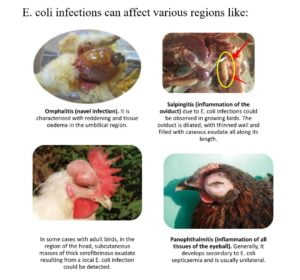
Aspergillosis: When the feed and litter get damp due to rainy water, poultry can easily catch the infection of fungus-like Aspergillosis. The symptoms of this infection include lesions that look like green and yellow nodules which fill the lungs, causing respiratory discomfort. This infection has incubation period of 2-5 days. Morbidity is usually low, but may be as high as 12% and mortality among young birds is 5-50%. Transmission is by inhalation exposure to an environment with a high spore count.
Coccidiosis: This is caused by a protozoan parasite of the genus Eimeria. the symptoms of this disease are mucus-like or bloody diarrhoea, dehydration, anaemia, listlessness, ruffled feathers, stunted growth, death, and sometimes drop in egg production.
Other physiological factors affecting chicken:
Decrease egg production: Chickens usually produce eggs in the daylight. During the rainy season, the daylight will be shortened or less and this causes a decrease in egg production.
Mudballs in chicken toes: When chicken walk regularly on this wet litter due to rain, the soil and manure get stuck in chicken’s feet and create mudballs. If you don’t clean up your chicken’s feet regularly, then this mudball gets bigger by time and may break your chicken’s toes.
Management during the rainy season: Various measures should be followed by a poultry farmer to maintain poultry productivity at its best during the rainy season.
Provide the heater/fluorescence light: During the rainy season, the temperature is low. hence, to make chicken’s body warm and encourage egg production provision of heater/fluorescence light should be there in poultry farm since this artificial light can act the same as the daylight.
Put oil/fat in the chicken’s feed: During the rainy season, chicken tends to eat more. Hence, to reduce the cost of their feed, some oil or fat can be added into their feeds. These oil and fats will provide higher energy and reduce feed production costs.
Prepare more dry padding: During the rainy season, humidity level increases. The wood dust that is used as bedding can get damp easily. Hence, there is a need to prepare more dry wood dust and extra bedding in the chicken coop to make them dry. Along with this, chicken’s bedding should be changed more often than usual.
De-wormers administration: During the rainy season, leaking water from various sources can deteriorate chicken’s health as it might bring many worms and parasites. Hence, de-wormers to be given to avoid infection with intestinal worms. Effective de-wormer can be piperazine that can be given once in 2 or 3 months.
Construct the roof overhang over the entrance and sides of pens: During the rainy season, to ensure that the water doesn’t get leak out into the chicken’s coop, some more roof overhang can be made over the entrance and sides of pens. This construction avoids the water leaking, while air circulates well through the ventilator.
Vaccination before the rainy season: We all know that “prevention is better than cure”. Hence, before the arrival of the rainy season, your chicken must be vaccinated.
Provision of antibiotics in the farm: Along with this, antibiotics should also be given routinely to poultry to boost up their immune system and for treatment purpose if any chicken is found to be ill.
Conclusion: There are certain climatic period poultry farmers must be aware of and how to maintain the best productivity level of their farm during this period is the key to the success of the poultry business; one of these periods is the rainy season. Hence, as a poultry farmer, it is very important to learn how to operate a poultry farm during the rainy season.
